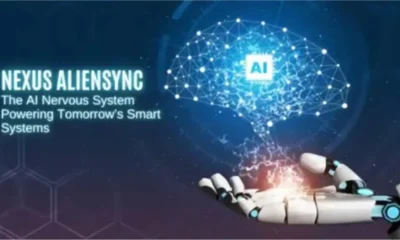AI
How Headless CMS Is Powering the Next Wave of AI-Generated Digital Experiences

Introduction
As AI (artificial intelligence) remains at the forefront of ongoing and future online engagement, companies are seeking niche opportunities to enhance their websites with this transformative experience. One of the most dynamic facilitators of such an opportunity is the unique structure provided by a headless content management system (CMS). A headless CMS possesses the infrastructure and adaptability to seamlessly allow for AI implementation across digital spaces. Therefore, this article explains why a headless CMS is the ideal implementation for facilitating the future of AI-generated experiences digitally.
Decoupled Architecture Equals Flexibility for Integration
The best part of a headless CMS is the decoupled architecture that naturally separates content creation and content display. This is an inherent advantage when integrating next-gen AI technology because developers and marketers can maintain a back-end management structure without the fear that any front-end opportunities will be compromised by AI. Choosing a robust Strapi CMS alternative further ensures brands can leverage complicated AI-driven experiences on the fly, thanks to the flexibility provided by a fully decoupled system. The ability to separate worlds means brands can integrate AI seamlessly without having to overhaul an entire content management system at its base.
Real-Time Personalization via AI is Simple and Effective
One of the best features of a headless CMS is that it makes real-time personalization so much easier that’s what’s required for AI-driven digital experiences. Using APIs, brands can leverage AI to provide content recommendations, unique experiences, and tailored messaging in real-time, based on learnings about a customer. Being able to get that type of personalization at such a granular level is ideal when it comes to conversion; the more a customer gets what they want, no matter where they are in their journey, the more likely they are to engage with the content and brand.
AI Content Optimization is Easier with Headless CMS
It’s easy to optimize content with AI using a headless CMS. Machine learning algorithms can be integrated via APIs with ease, meaning businesses can better understand how customers engage with their content, what’s working, what’s not, and levels of engagement can provide real-time suggestions. AI can let brands know how to best show their information, how to adjust while showing it, or how they should change their approach when creating a content strategy down the line. AI content optimization based on this understanding creates a consistently better experience for users, which fosters engagement and increases conversion over time.
Enabling Omnichannel AI Experiences
Consumers today interact with brands across an ever-expanding range of digital channels from websites to mobile apps to voice assistance and IoT devices. A headless CMS supports these omnichannel efforts naturally through the API-based creation and distribution of content. Thus, brands can seamlessly offer AI-generated opportunities for voice assistance, mobile push notifications, or smart device engagement. With a headless architecture, consistency is key across all channels, creating a stronger relationship with consumers for embedded and empowered AI experiences.
Nurturing New Innovation and Experimentation at Scale
AI-empowered digital experiences only come to be through testing and validation. Organizations must be able to experiment quickly and frequently. Headless CMS architecture encourages such experimentation at scale since it supports collaborative efforts, quick iterations, and swift launches of AI-focused content initiatives. Companies can easily create a minimum viable product for a new AI functionality, test it in the wild and, if successful, launch it with minimal friction. When it comes to new AI opportunities and emerging trends, speed is on the side of companies that adopt headless CMS architecture.
Enhancing Developer Efficiency for AI Adoption
Constructing the architecture needed to support advanced AI technologies requires extensive development time. A headless CMS increases developer efficiency by allowing them to work within their preferred frameworks and methodologies, which greatly reduces the complexity of AI adoption. Developers can utilize APIs to seamlessly connect the headless CMS backend to powerful AI technologies such as natural language processing solutions or predictive analytics tools. This decrease in development complexity fosters efficiency and turnaround times, allowing development teams to better focus their time on creating powerful AI-driven digital interactions.
Improved Customer Insights Through AI Headless CMS Integration Analytics
A headless CMS works in conjunction with AI analytical systems. Since these can also be integrated with APIs, companies can take advantage of AI without integration analytics to better understand customer patterns, needs, and engagement on a macro scale. This data allows marketers and content creators to produce more targeted and successful digital experiences that, in the long run, lead to improved customer satisfaction, loyalty, and engagement through education and successful, goal-oriented customer-content strategies.
Continued Digital Experiences Through AI Headless CMS Integration Flexibility For the Future
AI is a rapidly growing field that requires systems to be flexible and malleable to keep up with any changes that may happen down the road. Headless CMS solutions provide the flexibility that companies may need and will be the adaptability required to welcome any new or upcoming AI solutions without having to completely revamp the entire technological infrastructure. When companies decide to champion new AI advancements more advanced conversational engagements, unmatched AR/VR experiences, or stronger predictive analytics companies that have a headless CMS will easily be able to welcome and implement these new offerings to remain ahead of the curve in a market occupied by businesses that rely on AI to drive their deployments.
Easier Automation Workflows With AI-Enhanced Integration
Headless CMS solutions provide effective access and entry points more commonly referred to as APIs that make powerful automation workflows not only possible but necessary for any AI-influenced digital experience. For example, companies can create an API that automatically generates layouts by machine learning, converting what works best over time, automatically adjusting and rendering recommendations based on content suggestions, or automatically customizing every single path an end-user takes with intervention from trained AI. The more automated workflows there are, the less need for manual operations in content creation, which promotes operations and greater efficiency. This allows companies to replicate successes when it comes to AI-fueled digital experiences in an extensively customized approach.
AI And More Dynamic Interactions Facilitate User Engagement
User expectations for digital experiences and channels move faster than many companies can accommodate. Users want richer and more profound experiences digitally filled with interactivity. A headless CMS can power such AI-driven interfaces (i.e., interactive chatbots, virtual assistants, customizable UIs) by facilitating seamless points of access and compatibility via APIs. Therefore, engaging end-users in this fashion not only captivates their attention from within and externally but helps sustain engagement avenues and dramatically improves user satisfaction. Thus, a company can always adjust how it assists users with a headless integration approach because of the transformative options relative to changing consumer demand.
AI Integration Requirements Demand Security and Compliance
AI integration with digital experiences requires consideration of security and compliance. Headless CMS solutions come equipped with innovative security-related features that add layers of protection, such as complete access control, varied authentication tools, and audit trails providing an overview of transactions. Thus, the entering and exiting points between a headless CMS and other AI-driven solutions can occur through secure APIs, keeping even the most sensitive customer information secure during the AI-driven process. This advancement for security and compliance not only safeguards privacy but establishes trust and compliance where required in AI-driven digital experiences.
Reducing Technical Debt from AI Solutions
Technical debt is accrued over time, at an increasingly fast pace, based on the application of complicated AI solutions over legacy systems already in place. Headless CMS architectures reduce technical debt through modular, API-driven structures that create ease of access for integration expansion of singular components versus upgrades of the entire system. Legacy systems would have prioritized the need to upgrade an entire system at once, a gesture that can be overwhelming and require extensive long-term maintenance. Instead, AI integrations and components of the platform can change incrementally, which goes a long way in reducing intended maintenance efforts and costs down the road. This fosters a sense of continued creative growth in what can be created for digital experiences powered by AI, something that would otherwise become complicated to maintain over time.
Ultimately, leveraging a headless CMS architecture allows organizations to access the capabilities of AI and create stunning, dynamic digital assets in line with what they’re capable of. Organizations that welcome this flexible, scalable approach to a CMS system place themselves ahead of the game over competitors while continuing to make innovative strides in an increasingly AI-powered digital world.
Increasing Quality of Content Generated by AI Through Processing Improvements
Implementing an AI content generation process within a headless CMS increases the content generation pipeline by cutting out operational steps that would otherwise be counterproductive. Whether intentional drafts, personalized outreach pieces, or specific localization, able AI systems can create quality content on the fly. This works best when headless CMS applications connect via seamless APIs with powerful, trained external AI systems. Therefore, antiquated steps hinder the process, expose it to operational pitfalls and outdated time-to-completion opportunities. When time is saved generating, there are many more opportunities for qualitative expansion during strategic revision, ultimately making the experience much better for the end user.
Enhancing Performance with AI-Inspired Interventions
Users want to experience high-performing assets with little to no support. AI integration enhances performance factors as natural usage improves performance numbers; however, headless CMS architectures improve performance metrics via faster access and faster delivery. As these trends emerge, AI can support predictive caching, asset compression, and intelligent distribution of content based on expected use. All these increase intake speed for any channel and any device. Companies that enjoy headless architectures for their performance with AI performance enhancements have even greater opportunities for successful digital experiences as they see higher engagement and greater satisfaction from their users.
Empowering Cross-Functional Collaboration in AI Projects
AI-powered digital experiences are only as effective as cross-functional teams facilitate them to be. Often, organizations fail to execute due to the sheer inability of internal silos to effectively communicate across shared, yet separated goals. Developers and content teams might be on different floors or utilizing different collaborative software systems that fail to make efficient use of their time. Similarly, silos between marketing and operations can extend project timelines due to miscommunication. Yet with headless CMS architecture, these problems can be avoided. Creating collaborative intentions becomes easier when multidisciplinary teams work towards a goal.
This happens because a headless CMS allows access that empowers individuals in their respective projects yet simultaneously keeps them in the loop for an enhanced collaborative effort. For example, certain resources and content assets are compartmentalized yet more easily found and updated in real time through a headless CMS. Developers will understand where certain pieces or components can be found and how to create the AI elements for the digital experience through standards-based APIs. At the same time, the content team has their own focus but can ensure what they create will meet the needs of marketing and operations, as they can access that data in real time once created.
Therefore, communication remains transparent with real-time updates and a central location for all content materials. Collaboration becomes less stunted when teams do not have to operate based on outdated information or changes that evolve mid-process. Instead, they learn as they go how their ideas can grow or be constrained, and content and AI features can be iterated upon much quicker. This allows for less miscommunication as developers will have very specific instructions as to what they need to do while a separate team will not fight or struggle to find the work they accomplished. Instead, everything is known upfront, and teams can collaborate much more quickly, which reduces stumbling blocks and speeds up timelines.
Thus, this all provides a better competitive advantage within the marketplace. Companies that utilize headless CMS architecture to empower cross-functional teams will have the opportunity to be more agile, faster and turn around innovative ideas that boast higher quality than those who fail to find the same collaborative efforts without this specialized system. Enterprises will always be providing winning AI experiences that will resonate deeper with audiences because they were created in a quicker time frame with higher quality collaborative efforts than any other competitor.
-

 BIOGRAPHY7 months ago
BIOGRAPHY7 months agoBehind the Scenes with Sandra Orlow: An Exclusive Interview
-

 HOME1 year ago
HOME1 year agoDiscovering Insights: A Deep Dive into the //vital-mag.net blog
-

 HOME1 year ago
HOME1 year agoSifangds in Action: Real-Life Applications and Success Stories
-

 BIOGRAPHY1 year ago
BIOGRAPHY1 year agoThe Woman Behind the Comedian: Meet Andrew Santino Wife




























